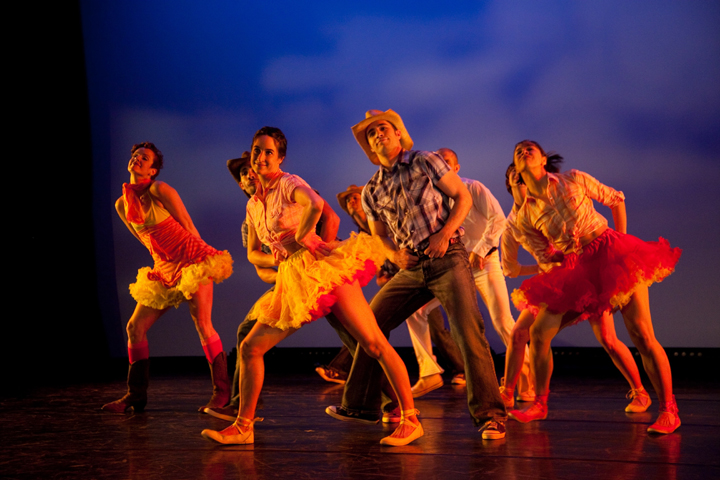On Mood and Motivation
Dance critic Lightsey Darst offers some thoughts on Zenon's new fall season production at the Ritz -- she found the show crowd-pleasing and the dancing exciting to watch, but is left with some questions about the motivations undergirding the movement.

IF YOU WANT TO HAVE DINNER, GO TO A SHOW, and get a drink, you could do worse than Zenon’s 27th fall season at the Ritz. Professional, lively, and varied, this concert is ideal for casual viewing, and the Ritz’s Northeast location, surrounded by bars and restaurants, is perfect for a convivial evening. However, if you’re looking for a new thought, if you want to change your life — if you are, in short, difficult — you could do better.
NYC-based Sydney Skybetter’s The Laws of Falling Bodies opens the show. A moody sketch, Laws offers some striking images: a dancer descending from a lift, headfirst, comes to a brief rest with her neck bent and head on the floor, like a bird who has mistaken glass for air, but lovely and still live; another dancer rebounds off the linked arms of her friends, her limbs shooting out electrically, as if in a child’s game gone wrong. I like the way gravity radiates from one body to another here, how one dancer jumps straight up and lands higher than he began, and it takes a second for the eye to realize he’s landed on someone else. But, altogether, the piece feels unmotivated. Who are these moody people, and what’s the matter with them? To judge by their dark lipstick and too-fashionable, Twilight-colored clothes, they might be hipsters who can’t find a coffee shop with wi-fi. It’s not that I really want to know, more that I don’t want to find myself wondering. Aside from some moments of inspiration, Skybetter’s movement doesn’t help elucidate things: it’s mostly familiar modern dance moves — artificially prolonged falls, finessed tumbles, and neck-wrench partner drops — which Skybetter deploys as if they comprised a classical vocabulary and needed no motive in themselves.
Emilie Plauché Flink’s Filament feels more motivated, right from its half-dark writhing opening. (Why writhe in the half-dark? Not because you mean to be seen.) The solo dancer (Tamara Ober) peels herself away from her junk sculpture home and reaches above her head, fingers fluttering, as if she were feeling a crown that slowly lifted away from her. Creaturely, she curls, opens, keeps opening until she falls into another curl. But then the music (a driving and various track from Jelloslave) takes over, the sculpture just sits there, unused, and the movement sinks into the unremarkable. Clare Brauch’s costume doesn’t help: brown Bermuda shorts? Where, outside of UPS, do those pass muster?
Megan McClellan and Brian Sostek’s Not From Texas is a fun dance farce, cowboy boots and noodle knees, short petticoats and chicken-pecking heads. Judith James Ries’s Here, now that you are gone… follows, performed in Danny Buraczewski’s jazz style. It’s a style I can’t appreciate — the swing always looks DOA to me, the soul whited-out — even though it’s crowd-pleasing.
______________________________________________________
Booba means “doll” in Hebrew, and these broken dolls stutter through silly-lewd dislocations like drunken prom queens, sometimes lip-synching along with the lovably bizarre Balkan Beat Box music.
______________________________________________________
Andrea Miller’s Booba is a goofy, twitchy ecstasy that I might love if the piece weren’t lopsided: it opens in ensemble, then a women’s dance, then a male-female duet, and then it’s done, without the necessary men’s dance and ensemble coda. Still, it’s something to be disappointed there’s not more. Booba means “doll” in Hebrew, and these broken dolls stutter through silly-lewd dislocations like drunken prom queens, sometimes lip-synching along with the lovably bizarre Balkan Beat Box music.
The dancing is good throughout — it’s Zenon, after all. Skybetter’s work, in particular, shows what difficult moves these dancers can turn into flow. One-footed, double-revolving balance? Deep arabesque into somersault? Why not? But, even among these capable dancers, Tamara Ober stands out: every step’s on, important, pushed to its edge. She acts, too. Acting isn’t always necessary, and it can detract (Mary Ann Bradley sometimes looks as if she’s trying to cut a corner by expressing with her face what we should read from her long body), but Ober’s open face adds to her dance. Altogether, with Ober, you always feel you’re seeing something special, that she’s breaking her record with each move, going farther than she’s gone before. Now, if only we could get the choreography to go with her.
______________________________________________________
Noted performance details:
Zenon Dance Company’s 27th Fall Season at the Ritz will be on stage at the Ritz Theater in Minneapolis for one more weekend of performances, November 27 – 29 (Friday and Saturday at 8 pm; Sunday at 7 pm).
About the writer: Lightsey Darst writes on dance for Mpls/St Paul magazine. She is also a poet who served as the founding coordinator of mnartists.org’s What Light: This Week’s Poem publication project, and the founder and host of a monthly writers’ salon, The Works, at the Bryant Lake Bowl.